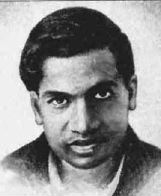

Srinivasa Ramanujan was born in India. He attended various primary schools before
entering the Town High School in Kumbakonam in 1898. There he was to do well in all his school subjects and showed himself an able all around scholar. In 1900 he began to work on his own on mathematics summing geometric and arithmetic series.
Ramanujan was shown how to solve cubic equations in 1902 and he went on to find his own method to solve the quartic equation. The following year, not
knowing that the quintic could not be solved by radicals, he tried to solve that as well.
Ramanujan came across a book writeen by Carr called Synopsis of elementary results in pure mathematics. This book, with its very concise style, allowed Ramanujan to teach himself mathematics, but the style of the book was to have a rather unfortunate effect on the
way Ramanujan was later to write down mathematics since it provided the only model that he had of written mathematical arguments. The book contained
theorems, formulas and short proofs. It also contained an index to papers on pure mathematics which had been published in the European Journals of
Learned Societies during the first half of the 19th century. The book, published in 1856, was of course well out of date by the time Ramanujan used it.
By 1904, Ramanujan had begun to undertake deep research. He calculated Euler's constant to 15 decimal places. He began to study what he thought were a new class of numbers, although he had independently discovered the Bernoulli numbers.
Ramanujan entered the Government College in Kumbakonam in 1904.
However his scholarship was not renewed because Ramanujan devoted more and more of his time to mathematics and neglected his other
subjects. Without money he was soon in difficulties, and he ran away to Vizagapatnam to
continue his mathematical work. He worked on hypergeometric series and investigated relations between integrals and series. He was to discover later that he had been studying elliptic functions.
In 1906, Ramanujan went to Madras where he entered Pachaiyappa's College. He failed an examination to enter the University of Madras, though he passed in mathematics. In the following years he worked on mathematics developing his own ideas without any help and without any real
idea of the then current research topics other than that provided by Carr's book.
Ramanujan studied continued fractions and divergent series in 1908. At this stage he became seriously ill and underwent an operation in 1909. He was married in 1909 to a nine year-old girl.
Ramanujan continued to develop his mathematical ideas and began to pose problems and solve problems in the Journal of the Indian Mathematical Society. He devoloped relations between elliptic modular equations in 1910. After publication of a brilliant research paper on Bernoulli's numbers in 1911, he gained recognition for his work. Despite his lack of a university education, he was becoming well known in the Madras area as a mathematical genius.
In 1913, Ramanujan wrote to Hardy having seen a copy of his 1910 book.
Hardy, together with Littlewood, studied the long list of unproved theorems which Ramanujan enclosed with his letter. They saw promise in the man, and Hardy brought Ramanujan to Trinity College, Cambridge, to begin an extraordinary collaboration.
Ramanujan sailed from India in 1914. Right from the beginning, however, he had problems with his vegetarian diet. The outbreak of World War I made obtaining special items of food harder and it was not long before Ramanujan had health problems.
Right from the start Ramanujan's collaboration with Hardy led to important results.
Littlewood was asked to help teach Ramanujan rigorous mathematical methods. However, he found this extremely difficult because every time some matter, which it was thought that Ramanujan needed to know, was mentioned, Ramanujan's response was an avalanche of original ideas which made it almost impossible for Littlewood to persist in his original intention.
In 1916, Ramanujan graduated from Cambridge with a Bachelor of Science by Research. His dissertation was on highly composite numbers, and consisted of 7 of his papers published in England. In 1918, Ramanujan was elected a fellow of the Cambridge Philosophical Society and a
fellow of the Royal Society. He returned to India in 1919, but his health deteriorated, and he died
the following year.
The letters Ramanujan wrote to Hardy in 1913 had contained many fascinating results. Ramanujan worked out the Riemann series, the elliptic integrals,
hypergeometric series and functional equations of the zeta function. On the other hand he had only a vague idea of what constitutes a mathematical proof. Despite many brilliant results, some of his theorems on prime numbers were completely wrong.
Ramanujan independently discovered results of Gauss, Kummer and others on hypergeometric series. Ramanujan's own work on partial sums and products
of hypergeometric series have led to major development in the topic. Perhaps his most famous work was on the number of partitions p(n) of an integer. MacMahon had produced tables of these for small numbers, and Ramanujan used this numerical data to conjecture some remarkable
properties some of which he proved using elliptic functions. Other were only proved after Ramanujan's death. In a joint paper with Hardy, Ramanujan gave an asymptotic formula for p(n). It had the remarkable property that it appeared to give the correct value of p(n), and this was later proved by Rademacher.
Ramanujan left a number of unpublished notebooks filled with theorems that mathematicians have continued to study. G. N. Watson published 30 papers which were inspired by Ramanujan's work.